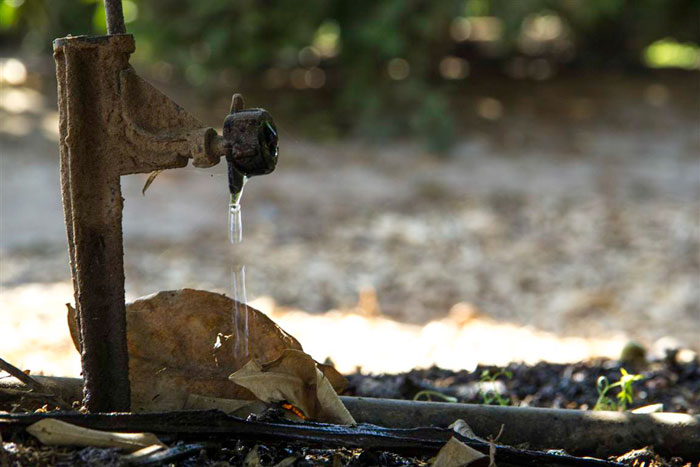August 17, 2016

Available free to almond growers is an online irrigation calculator which allows them to calculate irrigation schedules based on local growing conditions by integrating a number of variables.
It is supported by the Almond Board of California (ABC) and was designed in partnership with University of California irrigation experts and the consulting firm SureHarvest.
The irrigation calculator has been online for about three months.
Over the years, the Board has spearheaded a number of water-saving efforts, and this is just one added in the wake of media criticism over the amount of water required to grow almonds.
In a statement last year on sustainability, Richard Waycott, ABC president and chief executive officer, said growers over the last two decades had reduced the amount of water used to grow a pound of almonds by about 33 percent.
To use the irrigation calculator, growers enter information about their orchard, such as row and tree spacing, age, and percent canopy cover, along with optional inputs including soil texture and rooting depth.
The calculator automatically obtains weather data for necessary calculations from the nearest California Irrigation Management Information System (CIMIS) weather station, based on the zip code.
It will not provide calculations for flood irrigation, said Cliff Ohmart, vice president of professional services with SureHarvest, based in Davis, Calif.
“It works for drip, micro sprinklers and (solid set) sprinklers,” he said. Nearly 70 percent of almond growers conserve water with drip irrigation or micro sprinklers.
Ohmart said use of the software on a given site is password protected and the grower can assign accessibility to others as needed.
He said, “The idea is to make management as easy as possible but you have to want to do it.”
Gabriele Ludwig, the ABC’s director of sustainability and environmental affairs, was asked if growers are likely to be tech-savvy enough to come to grips with the learning curve needed to use the software. She believes they are.
“Ten years ago, forget it,” Ludwig said. “But they are increasingly using tablets and smart phones, and they don’t have to sit behind the desk at a computer.”
Moreover, she said internet service has expanded in rural areas, and there are more cell towers today.
Two almond growers discussed their experiences using the calculator. Both found it a user friendly and effective tool.
One of them, Chuck Dirkse, is a partner in a family operation, La Mancha Orchards, which grows almonds in Stanislaus and Merced counties. He was part of a focus group the Almond Board asked to review the program and provide feedback.
“Part of the idea is to get growers who are not using an irrigation management system to do so; to get people who are winging it to be more scientific,” Dirkse said.
While he said setting up the system can be a bit daunting, the software helps by making it so that “you don’t have to track down tons of data.”
To make it easier for calculator users to enter needed data, the software provides guidance for obtaining some of the required inputs.
For example, hover text and pop-ups are provided when a cursor is placed over highlighted text, providing additional information so the user doesn’t have to search for definitions of terms or details on steps to be taken.
Ludwig said, “The beauty of the irrigation calculator is growers can enter all the basic information from their orchard from one place, and the tool will calculate how much irrigation water (is) needed based on those specific conditions.”
The information can be cloned and modified for different orchard blocks, saving the effort of re-entering required input data for orchards. Growers can begin using the calculator at any time during the growing season.
Dirkse said his operation had come up with their own management system some time ago and continued to use it this year “because we’re used to it. Next year we will probably switch over.”
The other grower who discussed the calculator was Brandon Rebiero, who has orchards in Stanislaus and Solano counties and is also a pest control advisor. He likes the ease of using the program which took him about 30 minutes to load data on his orchard of mature trees. It can take longer, Rebiero said, for younger trees up to fifth leaf.
Both growers said the software allows users to do deficit irrigation which Rebiero practices in some orchard blocks. Rebiero said he prefers checking the irrigation schedule weekly though forecasts can be made further out.
Among advantages of having it place, Ohmart said, is the opportunity to collect data over time and then look back to “see what happened,” and perhaps modifying the applications accordingly.
Ludwig echoed Ohmart’s comments on the value of data documentation, adding that data can help the industry better tell its story, something that has increased in importance as the industry faces added scrutiny on water use and other sustainability issues.
In 2015, Mother Jones magazine published an article critical of the amount of water used to grow almonds which triggered other media reports.
Ludwig said almonds being nearly a million acre crop in California put the industry “in the eye of the storm of how resources are going to be used, particularly water.”
She said Millennials, those who reached young adulthood by 2000, want information.
“They expect transparency,” Ludwig said. “The world around us is expecting more information.”
The number of Millennials now exceeds the number of Baby Boomers as the largest living generation.
The irrigation calculator complements a new effort by the Almond Board that encourages all almond growers to adopt practices to improve irrigation efficiency. An almond irrigation improvement continuum was developed by the Board in partnership with the University of California, California State University, and UC Cooperative Extension specialists.
It includes five practices including: measuring irrigation system performance and efficiency, estimating orchard water requirements based on evapotranspiration, measuring the amount of water applied, evaluating soil moisture, and evaluating water status.
You May Also Like




